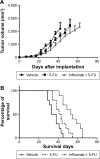Infliximab enhances the therapeutic effects of 5-fluorouracil resulting in tumor regression in colon cancer
- PMID: 27757041
- PMCID: PMC5055041
- DOI: 10.2147/OTT.S109342
Infliximab enhances the therapeutic effects of 5-fluorouracil resulting in tumor regression in colon cancer
Abstract
Colon cancer (CC) is among the most common malignant diseases with a dismal survival. Tumor necrosis factor-alpha (TNF-α) has been identified as a therapeutic target in various cancers, and anti-TNF-α treatment has shown promising effects in different cancer models. However, if TNF-α can be targeted in CC, the therapeutic values of anti-TNF-α treatment in CC remain unknown. Our study indicated that TNF-α is highly expressed in CC cell lines and patient tumor samples. High expression of TNF-α is an independent adverse prognosticator of CC. Targeting the TNF-α by its antibody infliximab induced antibody-dependent cellular cytotoxicity and complement-dependent cytotoxicity and enhanced apoptosis leading to cell death. The combination of infliximab with 5-fluorouracil showed better responses in vitro and in vivo than 5-fluorouracil alone. In conclusion, this study identified TNF-α as a target of CC and anti-TNF-α treatment synergized with chemotherapy leading to a better outcome in preclinical models.
Keywords: chemotherapy; colon cancer; prognosis; tumor necrosis factor-alpha; tumor regression.
Conflict of interest statement
The authors report no conflicts of interest in this work.
Figures






Similar articles
-
Oxaliplatin and Infliximab Combination Synergizes in Inducing Colon Cancer Regression.Med Sci Monit. 2017 Feb 12;23:780-789. doi: 10.12659/msm.901880. Med Sci Monit. 2017. PMID: 28190020 Free PMC article.
-
Oxaliplatin and infliximab synergize to induce regression of colon cancer.Oncol Lett. 2018 Feb;15(2):1517-1522. doi: 10.3892/ol.2017.7468. Epub 2017 Nov 22. Oncol Lett. 2018. PMID: 29434844 Free PMC article.
-
Prognostic and Therapeutic Values of Tumor Necrosis Factor-Alpha in Hepatocellular Carcinoma.Med Sci Monit. 2016 Oct 14;22:3694-3704. doi: 10.12659/msm.899773. Med Sci Monit. 2016. PMID: 27739418 Free PMC article.
-
A PEGylated Fab' fragment against tumor necrosis factor for the treatment of Crohn disease: exploring a new mechanism of action.BioDrugs. 2008;22(5):331-7. doi: 10.2165/00063030-200822050-00005. BioDrugs. 2008. PMID: 18778114 Review.
-
Infliximab: mechanism of action beyond TNF-alpha neutralization in inflammatory bowel disease.Eur J Gastroenterol Hepatol. 2004 Jul;16(7):639-41. doi: 10.1097/01.meg.0000108345.41221.c2. Eur J Gastroenterol Hepatol. 2004. PMID: 15201575 Review.
Cited by
-
Targeting cytokine and chemokine signaling pathways for enhancing chemo-sensitivity in colorectal cancer.Cell Commun Signal. 2025 Aug 12;23(1):369. doi: 10.1186/s12964-025-02235-7. Cell Commun Signal. 2025. PMID: 40796863 Free PMC article. Review.
-
Noncoding RNAs in inflammation and colorectal cancer.RNA Biol. 2020 Nov;17(11):1628-1635. doi: 10.1080/15476286.2019.1705610. Epub 2019 Dec 26. RNA Biol. 2020. PMID: 31847691 Free PMC article.
-
Comprehensive Testing of Chemotherapy and Immune Checkpoint Blockade in Preclinical Cancer Models Identifies Additive Combinations.Front Immunol. 2022 May 11;13:872295. doi: 10.3389/fimmu.2022.872295. eCollection 2022. Front Immunol. 2022. PMID: 35634282 Free PMC article.
-
Establishment of In Vitro and In Vivo Anticolorectal Cancer Efficacy of Lithocholic Acid-Based Imidazolium Salts.Int J Mol Sci. 2022 Jun 24;23(13):7019. doi: 10.3390/ijms23137019. Int J Mol Sci. 2022. PMID: 35806024 Free PMC article.
-
Human Mast Cells From Adipose Tissue Target and Induce Apoptosis of Breast Cancer Cells.Front Immunol. 2019 Feb 18;10:138. doi: 10.3389/fimmu.2019.00138. eCollection 2019. Front Immunol. 2019. PMID: 30833944 Free PMC article.
References
-
- Siegel R, Desantis C, Jemal A. Colorectal cancer statistics, 2014. CA Cancer J Clin. 2014;64(2):104–117. - PubMed
-
- Torre LA, Bray F, Siegel RL, Ferlay J, Lortet-Tieulent J, Jemal A. Global cancer statistics, 2012. CA Cancer J Clin. 2015;65(2):87–108. - PubMed
-
- Locksley RM, Killeen N, Lenardo MJ. The TNF and TNF receptor super-families: integrating mammalian biology. Cell. 2001;104(4):487–501. - PubMed
LinkOut - more resources
Full Text Sources
Other Literature Sources

